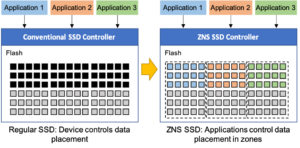By Matias Bjørling, NVM ExpressTM Member
Data growth has been exploding year-over-year. With the proliferation of artificial intelligence, IoT, and massive growth of video, we are just scratching the surface of how companies will be storing and extracting value from data. Yet, we are still architecting our software to use a generic storage interface, without considering how to effectively use today’s storage devices.
Storage devices, such as NAND-based Solid-State Drives, are a large part of the storage hierarchy in today’s storage infrastructures. They are deployed by hyper-scalers, all-flash vendors, and large storage systems, and are used for a multitude of various workloads. Their storage interface is simple and mimics existing storage interfaces.
However, NAND-based media with flash blocks as its building block, can handle only a certain number of writes, must be written sequentially, and erased before being rewritten. As a result, it must be managed. The SSD Flash Translation Layer (FTL) intelligently deals with everything from cache to performance, wear leveling, garbage collection, etc. However, this level of management brings indirection between the host and the actual media and impacts throughput, latency, and cost through the increase of:
- Write Amplification – Host writes are amplified internally in the SSD as the data is moved around due to the characteristics of the NAND-based media.
- Over-provisioning – The SSD over-provisions its NAND-based media to increase efficiently of internal garbage collection.
- DRAM – The SSD manages an internal logical to physical mapping table that typically requires one GiB of DRAM per 1TiB of NAND-based media.
To improve the performance of SSDs, the NVMe Technical Work Group is developing Zoned Namespace, an industry standardization that aligns the internals of SSDs with the host. Zoned Namespaces is the result of a multi-year effort in the storage industry, that takes advantage of learnings in Open-Channel SSD architectures, and in which hyper-scalers, all-flash array vendors, and large storage system vendors have been considering or currently use.
Our work is to broadly capture learnings and create a standardized interface, which allows a strong software and hardware eco-system to emerge. So far, standardization sponsors include Microsoft, Alibaba, and NetApp—all interested in large hyper-scaling models.
Zoned Namespaces is similar to the interface used by shingled magnetic recording (SMR) HDD’s (T13 ZAC/T10 ZBC). However, the interface also works remarkably well with NAND-based Solid-State Drives, as both devices shared the requirement of writing sequential to zones. Therefore, ZNS adopts the same terminology and also gets to utilize the existing software eco-system that has been built for SMR HDDs, thus greatly accelerating the adoption of this new interface.
The zone semantics aligns perfectly to the SSD internals, allowing the SSD to match the zone to the internals of the media, and thereby eliminate indirections and end-to-end integration between applications and SSDs. Correctly aligning data placement from the application to the SSD, allowing the host to understand data placement rules of the SSD while maintaining a generic interface where each end can innovate and improve.

The new NVMe Zoned Namespaces industry standard will be available to members and later to the public when the NVMe base specification 2.0 is released in 2020.
Zoned Namespaces offers the following SSD benefits:
- Reduced TCO due to minimal DRAM requirement per SSD.
- Potential savings due to decreased need for over-provisioning of NAND media.
- Better SSD lifetime by reducing write amplification.
- Dramatically reduced latency
- Significantly improved throughput
- Standardized interface enables a strong software and hardware eco-system.
Learn more about Zoned Namespaces development.
To view my complete presentation from the 2019 NVM Express Developer Day, download From Open-Channel SSDs to Zoned Namespaces on the NVM Express website.
Please join us at FMS 2019, one of the best networking events in the storage industry. Be sure to check out:
- Dave Landsman’s presentation titled, “Standardizing Zones Across the Storage Eco-System.” Dave is the Director of Industry Standards at Western Digital and an NVM Express Board Member, he has over 25 years in the semiconductor industry, is active in the SATA-IO Digital and CabCon WG’s and was a principal contributor to the SATA uSSD and DevSleep specifications.
- Matias Bjørling’s presentation titled, “Zoned Namespaces in Practice.” Matias is the Director of Solid-State SSD System Software at Western Digital, and an NVM Express Board Member. He is the author of the Open-Channel SSD specifications, Linux kernel maintainer of the Open-Channel SSD subsystem and is leading the ZNS technical proposal in the NVMe Work Group.
Want to get involved? All NVM Express members are invited to get participate in the development of the spec by joining technical work groups. Find more information on the members workspace.
